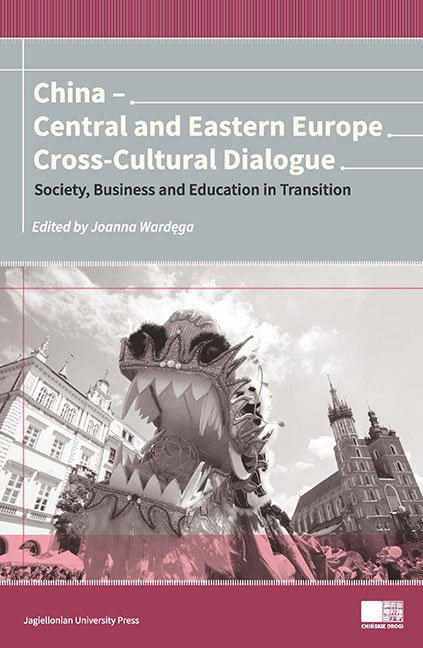Book contents
- Frontmatter
- Contents
- Foreword
- PART I Society and Culture in Transition
- PART TWO Economy and Markets in Transition
- PART THREE Education in Transition
- Opening the Two-Way Fast Lane for China-CEE Cultural Exchange by Equally Valuing the International Promotion of the Chinese Language and the CEE Languages Teaching
- A Contrastive Analysis of Traditional Chinese and Western Teaching Styles – A Case Study
- How Does Learning Style and Teaching Style Jointly Relate to Cultural Intelligence? A Study of Chinese Overseas Students
- Preparation of University Students from Western Cultures for Cooperation with China: Reasons and Methods
- Facing the Challenges of Teaching Chinese through Confucius Classrooms in Slovenian Schools: Current Situation and Prospects
- The Role of the Confucius Institute at Ss. Cyril and Methodius University in Skopje in Promoting the Chinese language, Culture and Business in the Republic of Macedonia
- Education in Transition of China-Based Jesuits from the Austrian Province
- Link in the History: The Development of the Research on Avguštin Hallerstein and its Contemporary Meaning
- Contributors
A Contrastive Analysis of Traditional Chinese and Western Teaching Styles – A Case Study
from PART THREE - Education in Transition
Published online by Cambridge University Press: 22 December 2017
- Frontmatter
- Contents
- Foreword
- PART I Society and Culture in Transition
- PART TWO Economy and Markets in Transition
- PART THREE Education in Transition
- Opening the Two-Way Fast Lane for China-CEE Cultural Exchange by Equally Valuing the International Promotion of the Chinese Language and the CEE Languages Teaching
- A Contrastive Analysis of Traditional Chinese and Western Teaching Styles – A Case Study
- How Does Learning Style and Teaching Style Jointly Relate to Cultural Intelligence? A Study of Chinese Overseas Students
- Preparation of University Students from Western Cultures for Cooperation with China: Reasons and Methods
- Facing the Challenges of Teaching Chinese through Confucius Classrooms in Slovenian Schools: Current Situation and Prospects
- The Role of the Confucius Institute at Ss. Cyril and Methodius University in Skopje in Promoting the Chinese language, Culture and Business in the Republic of Macedonia
- Education in Transition of China-Based Jesuits from the Austrian Province
- Link in the History: The Development of the Research on Avguštin Hallerstein and its Contemporary Meaning
- Contributors
Summary
In the process of second language teaching, both Chinese and Western teachers show their distinctive teaching styles as demonstrated by their different teaching approaches and roles. Generally speaking, the mainland ELT teachers prefer a more instructor-centered style of class management than Western teachers do, which is characterized by the form of “knowledge transmission from teacher to students” (cited in Xiao, 2006), while Western teachers tend to take a communicative approach and encourage students’ participation in class. There is no doubt that different teaching styles can exert different impacts on students’ learning processes and outcomes. Since teaching styles have become particularly important in the context of teaching English as a second language, identifying the teaching style can help language teachers, especially Mainland ELT teachers, gain a clearer insight into the embedded strengths and weaknesses so as to ensure positive learning outcomes and effective teaching.
Literature Review
“Teaching style is a teacher's individual instructional method and approach and the characteristic manner in which the teacher carries out instruction. Teachers differ in the way they see their role in the classroom, the type of teacher-student interaction they encourage, their preferred teaching strategies and these differences lead to differences in the teacher's teaching style” (Richards et al., 2005, p. 699). The difference between traditional Chinese and Western teaching styles, to a large extent, can be traced back to cultural influence. German linguist Hofstede (1980) points out the three cultural dimensions which affect Chinese L2 teaching and learning, including the “Power Distance Dimension” of Chinese teachers’ authority image and students’ submissiveness in the instructor-centered classroom, and “Collective-Individualistic Dimension”, focusing on the Asian value of seeing individuals as an inseparable part of an in-group and the Westerners’ stressing individual goals, needs and rights rather than the community (Hall, 1977; Hoftstede, 1980). In addition, teaching styles may vary from person to person, and there is no absolute criterion for judging a good style of teaching. The traditional Chinese teaching style may be an effective way to enable students to grasp fundamental facts, grammatical rules or sequences, while the Western teaching style emphasizes student engagement in classroom activities and fosters their critical thinking and independent learning.
- Type
- Chapter
- Information
- China - Central and Eastern Europe Cross-Cultural Dialogue Society, Business and Education in Transition , pp. 327 - 340Publisher: Jagiellonian University PressPrint publication year: 2016

